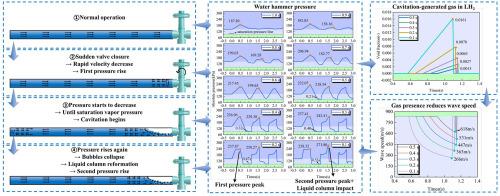考虑非定常摩擦和空化的液氢管道水锤数值模拟
IF 8.3
2区 工程技术
Q1 CHEMISTRY, PHYSICAL
引用次数: 0
摘要
液氢管道水锤引起的空化对管道运行安全构成威胁。建立了考虑非定常摩擦的空化流动模型,并通过实验数据进行了验证。与传统空化模型相比,该模型对无空化水锤和有空化水锤的平均预测误差分别降低了7.24和6.95个百分点。研究了阀门关闭时间、流速和过冷温度对水锤工况的影响。结果表明:阀门关闭时间越短,流速越高,水锤波速越小,波传播周期越长,造成的空化越严重;当阀门关闭时间为0.1 s时,第二个压力波峰值比第一个压力波峰值高出14.04%。流速每增加0.5 m/s,水锤压力平均增加31.78 kPa。尽管对峰值压力的影响很小,但较低的过冷温度显著增加了空化阻力。本文章由计算机程序翻译,如有差异,请以英文原文为准。

Numerical simulation of water hammer in liquid hydrogen pipeline considering unsteady friction and cavitation
Cavitation induced by water hammer in liquid hydrogen pipelines threatens operational safety. A cavitation flow model incorporating unsteady friction was established and validated via experimental data. Compared with traditional cavitation model, average prediction errors are reduced by 7.24 and 6.95 percentage points for the water hammer without cavitation and water hammer with cavitation by the proposed model. The effects of valve closure time, flow velocity, and supercooling temperature on water hammer conditions were investigated. The results show that more severe cavitation is caused by shorter valve closing time and higher flow velocity, while reducing water hammer wave speed and prolonging wave transmission cycle. At a valve closing time of 0.1 s, the second pressure wave peak exceeds the first by 14.04 %. Water hammer pressure is increased by 31.78 kPa on average per 0.5 m/s velocity increase. Cavitation resistance is significantly increased by lower supercooling temperatures despite minor effects on peak pressure.
求助全文
通过发布文献求助,成功后即可免费获取论文全文。
去求助
来源期刊

International Journal of Hydrogen Energy
工程技术-环境科学
CiteScore
13.50
自引率
25.00%
发文量
3502
审稿时长
60 days
期刊介绍:
The objective of the International Journal of Hydrogen Energy is to facilitate the exchange of new ideas, technological advancements, and research findings in the field of Hydrogen Energy among scientists and engineers worldwide. This journal showcases original research, both analytical and experimental, covering various aspects of Hydrogen Energy. These include production, storage, transmission, utilization, enabling technologies, environmental impact, economic considerations, and global perspectives on hydrogen and its carriers such as NH3, CH4, alcohols, etc.
The utilization aspect encompasses various methods such as thermochemical (combustion), photochemical, electrochemical (fuel cells), and nuclear conversion of hydrogen, hydrogen isotopes, and hydrogen carriers into thermal, mechanical, and electrical energies. The applications of these energies can be found in transportation (including aerospace), industrial, commercial, and residential sectors.
 求助内容:
求助内容: 应助结果提醒方式:
应助结果提醒方式:


